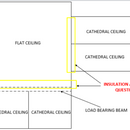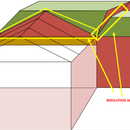Insulation between flat ceiling attic and cathedral ceiling
Zone 7A
I have a structure that was originally built with flat ceilings. After two additions (which are cathedral ceilings) I am wondering how I should insulate the walls of the flat ceiling attic from the floor of the attic up to where the top of the cathedral ceiling reaches in the attic. The two walls connecting to the cathedral ceilings have T1-11 on them since the additions were attached to the structure. There are various pieces of wood 2×4, 2×6 and 2×8 attached on the back of the trusses and the T1-11 so it isn’t clean looking. I am wondering if I should use vapor barrier against the T1-11 and various pieces of 2 by and then try to staple some batts of insulation along the attic wall or if there are better common practices out there when encountering this situation.
GBA Detail Library
A collection of one thousand construction details organized by climate and house part











Replies
Weekender,
The walls you describe should be insulated like any exterior wall. The walls separate the warm interior of your house (on the side of the wall facing the addition) from the cold exterior (the side of the wall facing the attic above the horizontal ceiling area).
If the framing is jumbled, the first order of business is to add framing or shims until you have co-planar framing.
In your climate zone, the vapor retarder should be on the warm-in-winter side of the assembly -- that is, facing the additions. But you don't need polyethylene. Either the kraft facing on fiberglass batts or vapor-retarder paint will work fine.
Making sure that you have an air barrier is much more important than the presence or absence of a vapor retarder. Pay attention to airtightness at every step.
Fiberglass batts are the worst type of insulation that is commonly sold, but fiberglass batts can work if they are conscientiously installed. Including a continuous layer of rigid foam in your wall assembly (on either side of the wall) will go a long ways toward improving the thermal performance of your walls.